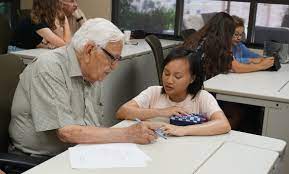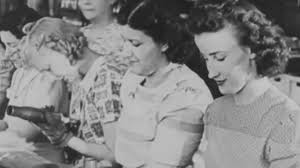I am a child of the 50s and 60s, so I am no expert about what it was like to be a child growing up in the 40s. That said, I have had conversations with plenty of people who did grow up in the 40s and they have all pretty much given me the same type of results about their youth.
The 1940s were a period in history marked by war, technological advancement, and cultural change. All of this presented a real challenge for the children trying to get to adulthood.
The War Years:
The Second World War waged across Europe, Africa, and Asia for six years. For children of the 40s, the war was a constant presence in their lives. There was rationing of food and goods, so there was a very real possibility that they might go hungry. Schools often held air raid drills to teach children to be prepared.
But despite this, there was a sense of community and solidarity because everyone was experiencing the same things. Children helped with the war effort by collecting scrap metal, helping to grow vegetables for the family, and they made things to send to the soldiers abroad.
For quite a lot of families, the male (husband, oldest son, uncles, etc.) were absent because they were overseas fighting the war. Mothers and daughters stepped in to fill the vacancies left by the men, so children were taught to be resourceful and to be helpful and to do what they could to help the war effort.
The Technological Advancements:
Technology was rapidly growing. There was the development of the jet engine, radar, and most importantly, the atomic bomb. These represented a sense of hope and possibility for the future.
The biggest technological advancement was the television. It technically was invented in the 30s, but did not become widely available until the 40s. For the first time, families could gather around the television to watch news broadcasts about the war, to watch sports and entertainment which helped to alleviate some of their anxiety about the war and their loved ones.
The Cultural Changes:
The war brought women into the workforce in large numbers which lead to a sense of empowerment and independence for them. They were able to discover their abilities and strengths. For most women, they saw their lives only in view of being a housewife and caring for home and children. During the war, they were able to see that life held more for them and they were able to succeed at various jobs once only held by men. The men returning from war had a time adjusting to the changes that this war brought to them and their families.
The war also renewed the sense of patriotism and pride in America, and that was reflected in popular culture like movies, music, and literature. Many of these popular items remain favorites even today.
The Home Life:
For children in the 40s, home life was centered around family and community. They played outside or read books or even listened to the radio for fun. Mealtimes were spent with their families; they would share stories and tell tales about the day. Often, extended family members came to share the meal and catch up on the family news.
Children went to school as education was highly valued. Usually they attended only through the 8th grade, and for those who wanted to continue there were very limited options. Many would choose vocational training instead because of the cost of continuing educations.
Looking Back:
The 40s were a time of hardship and challenge, but also hope and resilience. This era created vivid and meaningful memories for all. As we look back, we need to appreciate the sacrifices and achievements of those who lived then. There are lessons to be learned so that their sacrifices will not be forgotten.
Despite the challenges faced in the 40s, those who lived through the war years found ways to persevere and thrive. They proved that even in the darkest time in our history, it was possible to find hope and strength.
The sense of community and coming together in a time of crisis helped many to brave this period of history. During this time, everyone looked out for each other, sometimes even pooling resources to support each other. Their sense of solidarity helped build a stronger and more resilient society.
In the 40s, education was highly valued as was investing in the future. Education seemed to be the way to a better life by ensuring that their children had the skills and knowledge they would need to succeed in a rapidly changing world.
In conclusion, being a growing child in the 40s was a unique and challenging experience marked by war, shortages, community support, technological advancements, and cultural change. Even knowing all this, we cannot fully understand what those experiences were like; but we can honor their legacy and try to continue to build an better future for generations to come.


















